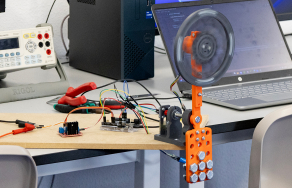Physical Review Letters (PRL) recently featured, in open access, the article “Unveiling the Hidden Pathway: How Axion-Plasmon Conversion Reshapes Our Search for Dark Matter”, authored by lecturer and researcher Hugo Terças (DF/ISEL), due to the relevance of the topic.
In the article, the ISEL professor, in collaboration with Tito Mendonça (GoLP/IPFN) and Robert Bingham (Rutherford Appleton Laboratory), unveils a new mechanism for axion conversion in neutron stars that could significantly reshape the way we search for dark matter. The researchers found that, before converting into detectable radio signals, many axions silently transform into plasma waves (plasmons) within the magnetospheres of these stars, thereby reducing the expected signals.
This discovery challenges current approaches and calls for a reassessment of detection strategies, reinforcing the role of theoretical research in advancing Astrophysics and positioning ISEL at the forefront of fundamental Physics.
It is worth noting that Physical Review Letters is a highly prestigious, peer-reviewed scientific journal that publishes high-impact research in Physics and related fields. Known for its editorial rigor and fast publication process, PRL is one of the leading platforms for the dissemination of groundbreaking discoveries, making significant contributions to the global advancement of scientific and technological knowledge.
Below is the article’s descriptive text:
Dark matter constitutes approximately 85% of the matter in our universe, yet its fundamental nature remains one of the most profound mysteries in modern physics. Among the leading candidates are axions—hypothetical particles originally proposed to solve a fundamental symmetry problem in quantum chromodynamics. These elusive particles could simultaneously explain dark matter and resolve a decades-old puzzle in particle physics.
Neutron stars, particularly magnetars with their immensely powerful magnetic fields, have emerged as natural laboratories for axion detection. As dark matter axions stream through these extreme environments, they should convert into detectable radio waves through a process known as axion-photon conversion. This mechanism has formed the basis for numerous observational campaigns using the world's most sensitive radio telescopes.
In groundbreaking research recently published in Physical Review Letters, Hugo Terças from ISEL's Department of Physics (Instituto Superior de Engenharia de Lisboa), in collaboration with Tito Mendonça from GoLP/IPFN and Robert Bingham from the Rutherford Appleton Laboratory, has revealed a previously overlooked phenomenon that substantially alters this picture. The research team discovered that before axions can convert into detectable radio waves, a significant portion instead convert into plasma waves (plasmons) deep within the neutron star's magnetosphere. This "silent" conversion pathway acts as an energy drain, diminishing the expected radio signals that astronomers search for.
This discovery, emerging from ISEL's growing research excellence in fundamental physics, forces a major reassessment of dark matter detection strategies. The anticipated radio signals from axion conversion may be substantially fainter than previously predicted, meaning current experimental constraints may be too optimistic, and future searches must account for this damping effect. This interdisciplinary work connects fundamental particle and plasma physics with astrophysical observations, demonstrating how theoretical insights from engineering physics can reshape our understanding of the cosmos.
The journey to detect dark matter requires not just powerful telescopes but also deep theoretical insights into how these elusive particles manifest in observable signals. This discovery of axion-plasmon conversion represents exactly this type of insight—one that moves us from looking for what we expect to see to understanding what we might actually find, while positioning ISEL at the forefront of cutting-edge astrophysical research.







